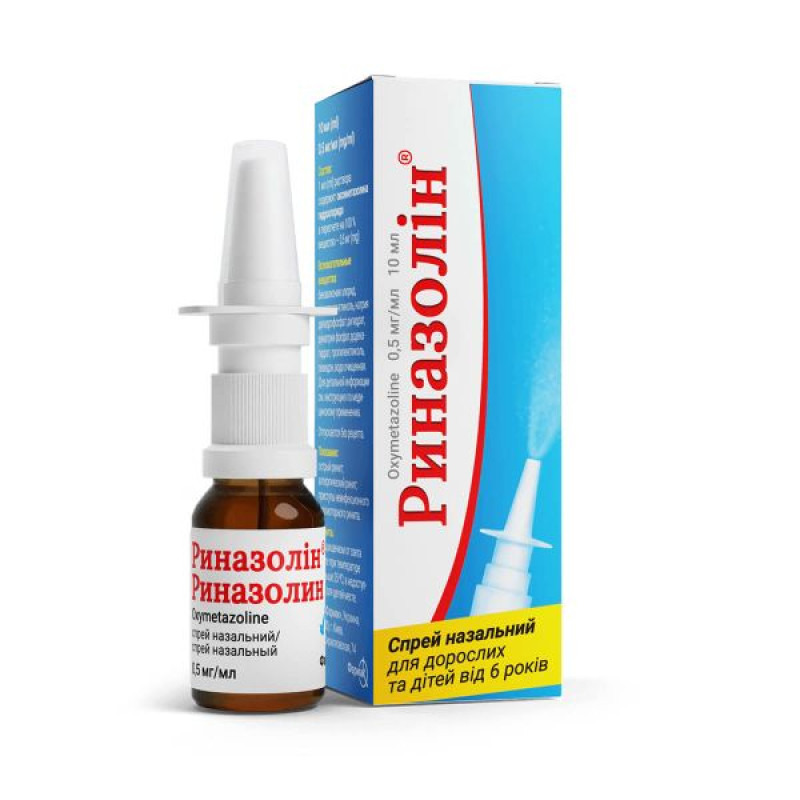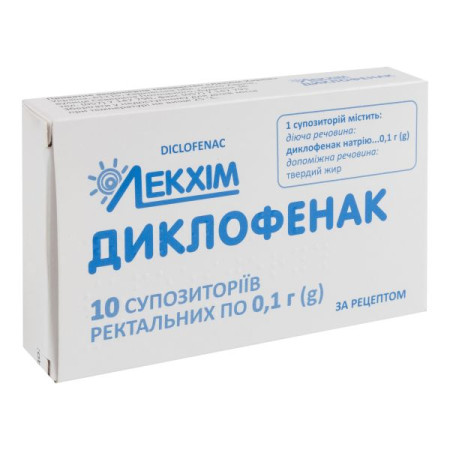Rinazolin nasal spray 0.5 mg/ml bottle 10 ml

Instructions Rinazolin nasal spray 0.5 mg/ml bottle 10 ml
Composition
active ingredient: oxymetazoline;
1 ml of solution contains oxymetazoline hydrochloride, calculated as 100% substance, 0.5 mg;
Excipients: benzalkonium chloride, polyethylene glycol, sodium dihydrogen phosphate dihydrate, disodium phosphate dodecahydrate, propylene glycol, povidone, purified water.
Dosage form
Nasal spray.
Main physicochemical properties: clear colorless or slightly yellowish liquid.
Pharmacotherapeutic group
Anti-edematous and other drugs for topical use in diseases of the nasal cavity. Sympathomimetics.
ATX code R01A A05.
Pharmacological properties
Pharmacodynamics
Rinazolin® belongs to the group of local vasoconstrictors. Oxymetazoline has a sympathomimetic and vasoconstrictor effect, eliminating swelling of the nasal mucosa. Narrows the vessels at the site of application, reduces swelling of the nasal mucosa and upper respiratory tract, reduces nasal discharge. Restores nasal breathing. Elimination of swelling of the nasal mucosa contributes to the restoration of aeration of the paranasal sinuses and the middle ear cavity, which prevents the development of bacterial complications.
Oxymetazoline has antiviral, anti-inflammatory, immunomodulatory and antioxidant effects. Thanks to this combined mechanism of action, clinical studies have proven a faster and more effective elimination of symptoms of acute rhinitis (nasal congestion, rhinorrhea, sneezing, malaise).
Pharmacokinetics
When applied topically to the nose in therapeutic concentrations, it does not irritate the nasal mucosa or cause hyperemia. The half-life is approximately 35 hours after administration. 2.1% of the drug is excreted by the kidneys, approximately 1.1% in the feces.
The duration of action of the drug is up to 12 hours.
Indication
– Acute rhinitis.
– Allergic rhinitis.
– Attacks of non-infectious vasomotor rhinitis.
– To restore drainage and nasal breathing in diseases of the paranasal sinuses of the nasal cavity, eustachitis associated with rhinitis.
– To eliminate edema before diagnostic manipulations in the nasal passages.
Contraindication
- Hypersensitivity to oxymetazoline or any other component of the drug.
- Atrophic rhinitis.
- Do not use after transsphenoidal hypophysectomy or other surgical procedures involving exposure of the meninges.
- When using monoamine oxidase inhibitors (MAO) and within 2 weeks after stopping treatment with MAO inhibitors, and when using other drugs that contribute to an increase in blood pressure.
- Increased intraocular pressure, especially in angle-closure glaucoma.
- Severe forms of cardiovascular diseases (e.g. coronary heart disease) and arterial hypertension.
- Pheochromocytoma.
- Metabolic disorders (e.g. hyperthyroidism, diabetes mellitus).
- Prostatic hyperplasia.
- Porphyria.
Interaction with other medicinal products and other types of interactions
Concomitant use of oxymetazoline with MAO inhibitors of the tranylcypromine type, tricyclic antidepressants, and antihypertensives may increase blood pressure. Therefore, these drugs should not be used together.
Application features
Long-term use and overdose of the drug should be avoided. Long-term use of a nasal decongestant may lead to a weakening of the drug's effect. Abuse of this drug may cause mucosal atrophy and reactive hyperemia with rhinitis medicamentosa. Doses higher than recommended should be taken only under medical supervision.
The presence of benzalkonium chloride in the composition of the drug in an amount of 18 mcg in a single dose may cause bronchospasm.
Use during pregnancy or breastfeeding
Pregnancy.
During pregnancy or breastfeeding, the drug should be used with extreme caution. Do not exceed the recommended dosage.
Breast-feeding.
Data on the penetration of oxymetazoline into breast milk are unknown. The drug should be used during breastfeeding only if the benefit-risk ratio is carefully assessed. During breastfeeding, the recommended dosage should not be exceeded, as an overdose may reduce the amount of breast milk in the mother.
Ability to influence reaction speed when driving vehicles or other mechanisms
After prolonged use of the drug in doses exceeding the recommended ones, a general effect on the cardiovascular system cannot be excluded. In such cases, the ability to drive may be impaired.
Method of administration and doses
Method of application of the drug from glass bottles equipped with dosing pumps with a sprayer
Clean your nose thoroughly before using the product. Immediately before use, hold the bottle of the product in your hand to warm it to body temperature. Remove the protective cap from the bottle.
While in an upright position, place the tip in each nasal passage alternately and press the pump-dispenser. It is recommended to inhale slightly through the nose during injection. After use, close the bottle with the cap.
Method of application of the drug from polyethylene bottles equipped with a nozzle with a dispenser and a protective cap
Clean your nose thoroughly before using the product. Immediately before use, hold the bottle of the product in your palm to warm it to body temperature. When using the product, hold the bottle vertically, with the spray tip facing up.
Before use, remove the protective cap from the bottle.
Place the tip into the nasal passage, squeeze the bottle with a short, sharp movement and, removing the tip from the nose, unsqueeze it. It is recommended to inhale slightly through the nose during the injection.
- After using the drug, close the bottle with a protective cap and store according to the recommendations given in the instructions.
To prevent infection, each vial of the drug may only be used by one person.
Adults and children over 6 years of age – 1 spray into each nasal passage 2–3 times a day. A single dose should not be used more than 3 times a day and for longer than 5–7 days. Doses higher than recommended should not be used.
The drug can be used again only after a few days.
Children
Assign to children aged 6 years and older.
Overdose
After a significant overdose or accidental ingestion, the following symptoms may occur: mydriasis, nausea, vomiting, cyanosis, fever, cramps, tachycardia, palpitations, arrhythmia, cardiovascular failure, cardiac arrest, increased sweating, agitation, convulsions, arterial hypertension, pulmonary edema, respiratory disorders, pallor, miosis, hyposmia, mental disorders.
In addition, central nervous system depression may occur, manifested by drowsiness, decreased body temperature, bradycardia, hypotension, apnea, and possible development of coma.
Therapeutic measures in case of overdose: gastric lavage, administration of activated charcoal, ventilation of the lungs. In case of lowering of blood pressure, phentolamine should be used. Vasopressors should not be taken. If necessary, anticonvulsant therapy is indicated.
Adverse reactions
Adverse reactions are classified by frequency of occurrence into the following categories: very common (≥ 10%), common (≥ 1% and < 10%), uncommon (≥ 0.1% and < 1%), rare (≥ 0.01% and < 0.1%), very rare (< 0.01%) and rare cases.
From the nervous system.
Very rare: restlessness, insomnia, increased fatigue (drowsiness, sedation), headache, hallucinations (especially in children).
From the cardiovascular system.
Rare: palpitations, tachycardia, hypertension.
Very rare: arrhythmias.
On the part of the respiratory system.
Common: nasal discomfort (e.g. burning) or dryness of the nasal mucosa, sneezing.
Uncommon: after the effect of using Rinazolin® wears off, there is a feeling of severe nasal congestion, nosebleeds.
Very rare: Apnoea in infants and newborns.
On the part of the musculoskeletal system.
Very rare: convulsions (especially in children).
From the immune system.
Uncommon: hypersensitivity reactions (angioedema, rash, itching).
Expiration date
3 years.
Do not use the drug after the expiration date indicated on the package.
Storage conditions
Store in a place protected from light and out of reach of children at a temperature not exceeding 25ºС.
Packaging
15 ml in a polyethylene bottle equipped with a nozzle with a dispenser and a protective cap. Or 10 ml in a glass bottle equipped with a pump-dispenser with a sprayer. 1 bottle in a pack.
Vacation category
Without a prescription.
Producer
JSC "Farmak".
Location of the manufacturer and its business address
Ukraine, 04080, Kyiv, Kyrylivska St., 74.
There are no reviews for this product.
There are no reviews for this product, be the first to leave your review.
No questions about this product, be the first and ask your question.








